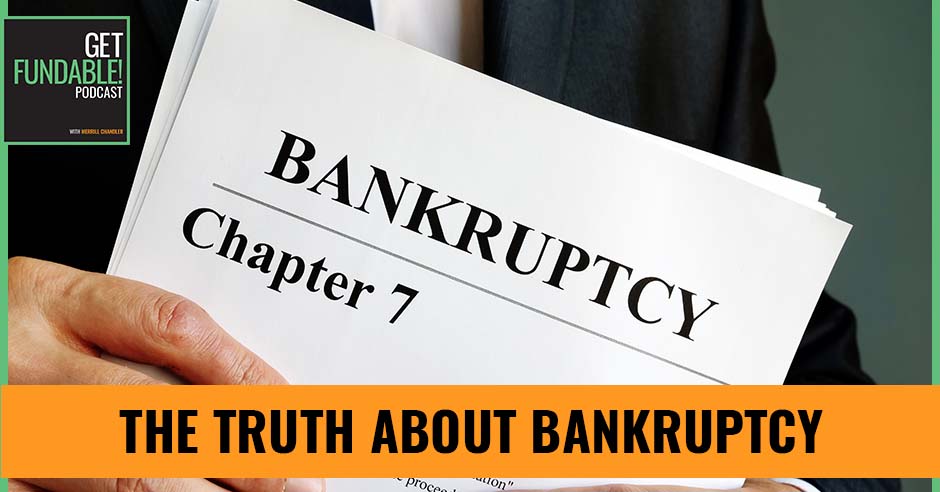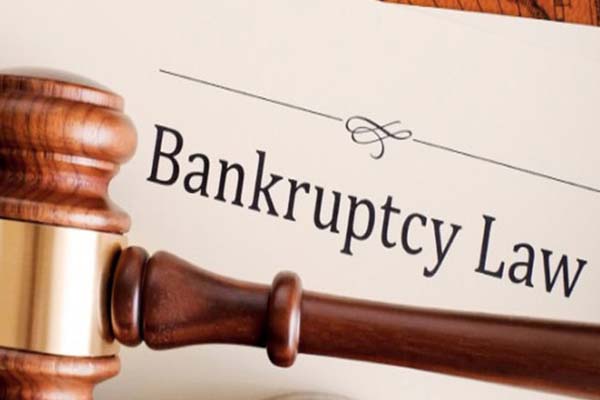
What is the truth about declaring bankruptcy? In today’s episode, Merrill Chandler defines bankruptcy and walks you through how, why, and when it happens. It doesn’t end there. Merrill also shares how bankruptcies impact your future transactions and what you can do to maintain a positive relationship with your lenders. Get your dose of financial knowledge with tips on debt reparation, negotiation, and more as we dive deep into the topic.
—
Watch the episode here
Listen to the podcast here
The Truth About Bankruptcy
I cannot wait for you guys to read this episode. We start the process of evaluating bankruptcies, burn lists, and how to build the most amazing relationships with banks you will ever have. I’ll see you on the inside.
—
As I said in the intro, bankruptcy, in all 170-some episodes, I have failed those of us who are going through COVID and recession. Folks who are facing bankruptcy, it’s about time we talk turkey about what you’re up against deciding about bankruptcy, and maybe even how to do a “soft landing.” Let’s take a look at what bankruptcy is, how it has evolved a little bit, and what it means now. What it means now is radically different than what it was last decade, in the 2000s, and in the 1990s. The true effects and the true efficacy of bankruptcy is different, and it has evolved. We need to be caught up because a bankruptcy attorney wants you to use them to do a bankruptcy.
What is Bankruptcy?
Let’s find out what the skin is. Number one, let’s go biblical. Let’s go epic on this. There was a time. Bankruptcy is the codification of the Mosaic law. There was a time when the debt was good for seven years, and after seven years, the debt was forgiven. You didn’t have debt after seven years. That went through the entire Medieval period, the Renaissance, the Enlightenment, and all the way to the Industrial Revolution.
When we ended up in the 1930s, ‘40s, ‘50s, ‘60s, and even into the ‘70s, this law of forgiving debt after seven years ended up codified as how long a record stays on your credit profile. Bankruptcy, when you pay it back, it lasts for seven years after you paid back the debt. They were added in the early parts of the 20th century. The bankruptcy courts were designed to formalize somebody whose quality of life was ruined to such a degree that the debt was forgiven.
The bankruptcy courts were designed to formalize somebody who legitimately could not pay, where their quality of life was ruined to such a degree that the debt was forgiven. Share on XWe’re going to be careful about our terms here. Bankruptcy is a Federal court. It is not a State court. There’s no such thing as a State bankruptcy court. It’s a Federal Law. Federal bankruptcy court allows you to choose 1 of 2 types of bankruptcy. A Chapter 7 Bankruptcy is the forgiveness of all debt, and you can reaffirm some debt like, “Can I keep paying for my house? Can I keep paying for my car? I can afford those still, but my revolving debt, installment loans, private debt, and all those could be put on a list.” It’s called a creditor’s list. Every debt is put on a creditor’s list. It’s submitted to the trustee. It’s not a judge that rules over the bankruptcy court. It’s a trustee whose job is to balance the needs of the creditors and the lenders against the needs of the borrowers.
They’ve been pretty pro-borrower because that was the intention of the bankruptcy court being established in the first place. It was because lenders would charge interest forever, hold captive a borrower, and would garnish wages forever before it was punitive. I have no problem with there being a third-party escape capsule for a borrower to be able to recalibrate their financial lives.
Having said that, over the last few decades, lenders would write off whatever debt was included and not reaffirmed inside of the bankruptcy. They’d sign off on it. They’d write it off. Sometimes a practice started in the 2000s, more in the 2010 decades where they would send a 1099 miscellaneous income because if you borrowed $20,000 and you went bankrupt on $20,000, it’s like you’ve got an income of $20,000. A 1099 would be sent to you, and you’d have to report it on your taxes as income because it was never paid back.

Bankruptcy: It’s not a judge that rules over the bankruptcy court. It’s a, it’s a trustee whose job is to balance the needs of the creditors and the lenders against the needs of the borrowers.
You don’t pay taxes on loans that you pay back. The income used to pay back a loan is not taxable because you’re paying something back. There’s no income. If you don’t pay it back, they see this little loophole, “Let’s charge them taxes,” and that would be a write-off for the lender. They’d be able to write it off on their taxes. That was more punitive as well.
Lenders can write off uncollectible debt without sending a 1099. It was punitive. It was a dirty business. The lenders were like, “That borrower did me dirty. Let’s charge it against their taxes,” even though the lender could already write it off, take it off their books, and since it was a loss, no problem, but doing them dirty, there are all kinds of moral arguments one way or the other. I’m simply saying that there are some organizations that were more prone to doing this than others.
Bankruptcies May Be Forgiven But Not Forgotten
It was an elective. It wasn’t mandatory to write it off. You didn’t have to give a 1099 miscellaneous to a borrower. It was punitive. It was a punishment. It has even become more precarious now for borrowers who are considering bankruptcy. A bankruptcy is a third-party intervention by the United States bankruptcy court to say they don’t owe you anything any longer. What’s interesting, however, is that now bankruptcies, while it may forgive the debt, the institutional memory of the lender is staying 100% keyed into that borrower.
We get back what we give so give first. Share on XThese lenders now are remembering how much you owe. American Express was one to start it out, and there’s Wells Fargo. The top four banks, tier one banks, and many tier two banks are all now starting to remember and keep on their books. One of the data points in automatic underwriting is, “Do we recognize this borrower and their Social Security number, their identifying information? Do they owe us money?” It pings their own internal databases.
When you do a bankruptcy, they don’t just look at your credit report. Let’s say you did a bankruptcy 7 years ago, and in 10 years, the Chapter 7 is off your credit report. There is no evidence on your credit report that there’s bankruptcy. I’ve had clients go, “Why am I not getting accepted by Wells Fargo? It’s been twelve years since I did my bankruptcy and included their account in the bankruptcy.” Let’s call it $5,000 for our example, “Why aren’t they lending to me?” I have to remind them, “You still owe them money.” They’re like, “Yeah, but I did a bankruptcy.” No, you had a third party come in and say, “Forgive them of the debt. It’s the law.”
To do banking in the United States, I’ve got to forgive somebody the debt. If they file and include me in the creditor list and my $5,000, I have to do banking in the United States, I have to forgive that debt, but I do not have to forget it. When I’m filling out my application, pings Merrill Chandler, my identity and says, “Does this borrower owe me money?” If the answer is yes, it comes back as an immediate decline. Sometimes, even the reason code says, “Current outstanding balance.” “But I did it in a bankruptcy.” That’s why I’m holding this particular show and why it’s relevant now because it doesn’t matter that you filed a bankruptcy.

Bankruptcy: While bankruptcies may forgive the debt, the institutional memory of the lender is staying 100% keyed into that borrower.
Let’s put it in a family context. The brother lends the sister $50. The brother wants the $50 from the sister. Mom says to the sister, “You don’t have to pay him back.” The brother says, “Fine, whatever.” Is the brother going to lend the sister money again when she already owed him $50, but it was forgiven by mom, the authority in the conversation? No, he is not going to ever lend to her again. He’ll say, “You give me back my $50, and I’m happy to set up another arrangement to lend you money, sis.”
It’s the same thing that is going on in the current environment. Lenders ping the data point to see if you already owe the money. If they don’t, they say no to you. We even say, “Current outstanding balance,” even if it’s not on the credit report. We’ve got to remember, the lender database is different than the credit report bureaus that are recording data and can only keep data on for 7 to 10 years. Seven years in the case of a Chapter 13 Bankruptcy after it’s been discharged, and 10 years after Chapter 7 discharge. That does not take it off the books of the lender.
How To Build And Maintain Relationships After Bankruptcy
At Fundability Inc., we call it the burn list. A burn list is you’re on their burn list. You burned their bank for $1,000, $2,000, $5,000 or $20,000. Until you pay that money back, you’re likely to never get another dime from them. They’ll remind you of this fact. Interestingly enough, as part of our fundability modeling, if you want to continue to build that relationship, we want you to pay them back.
What message does it send to the ether, to the universe, to all that is divine in the world, when you stand in your integrity to say, “Thank you for giving me money. I will pay you back even if I don't have to.” Share on XHere’s the way, and this is what you guys need to take notes on or otherwise. What you do is you call up the phone number and say, “I used to have an account with you. I included it in bankruptcy.” Bankruptcies are not the only way. Let’s say it got charged off. You never paid it and it got charged off. No matter what, it’s still owed, “I owe you money. I want to know how much money I owe you. I love my relationship with you, Chase, B of A, BB&T, Wells Fargo, and whomever. I want to know how to repair this relationship.”
Think of it as a separation of you and your spouse, you and your loved one, estranged family members. You’re making an offer, “I want to repair this relationship. How do we go about that?” Usually, you want to talk to a supervisor. Sometimes, you may want to talk to the executive office. It’s a backdoor number where manual underwriting criteria happen. You can look for those backdoor numbers online, but you want to talk to somebody who can take a moment. We’ve recommended clients to write a letter to the CEO of that. The CEO is not going to answer you, but they’re going to get it to somebody who is going to help you rebuild the relationship with the bank. Instead of the rank and file phone call answers, it’ll likely go to the underwriting department.
Once you get in contact with the person who’s going to manage your case, “I want to repair my relationship with your bank. I understand I owe you $5,000. I want to have my whole relationship back. If I paid off less than the full balance, would that make us whole, or do I need to pay the entire balance? I want to do whatever it takes to have this relationship again.” Sometimes they may allow less than the full balance. Sometimes they may ask for the full balance because you borrowed the full balance.

Bankruptcy: We call it the burn list. You burned their bank for 1000, 2000, 5000, 20000, and until you pay that money back, you’re likely to never get another dime from them.
I’m going to use a silly example. It’s like, “Honey, I want to come back. I know I had an affair. I promise I’ll only have one affair a month if you take me back.” No, you want to make an agreement with your spouse and honor the agreement, whatever it is. If they accept you are having one affair a month, then that’s the agreement. The point is you get to make the agreement with your partner, the lender, and honor it.
You borrowed the full $5,000 in this case. Figure out a way to retire that, but I promise you, I’ve never seen an example of it. The second you flip that switch, when they say, “Zero balance, no money owed,” you have created goodwill. You’ve got to make sure that they’re taking notes on this. Their notes say, “Post-bankruptcy, post-charge off,” whatever it was that caused you to not pay it back. “Post-bankruptcy, the borrower came back and asked to rebuild the relationship with us. They have paid it in full or paid the new agreement,” or whatever it was that you negotiated with them.
Be generous on their part. They forgave your damn debt several years ago. Be generous back to them. If you are lending money, you want the person to come back and be generous with you. We get what we give. Please be generous. Because they’re big institutions, I’m assuming you would love to be Chase Bank or Wells Fargo. You started out small, started lending, and you became a behemoth lender because of your astuteness in lending. Be generous with them. We get back what we give. Give first.
Once you have made that agreement, that’s what creates goodwill. They will make meticulous notes, especially if you remind them to make meticulous notes on your efforts to rebuild the relationship. They will document it. You will be back in the good graces. You might likely be awarded more opportunities because look at the message you sent. After several years, they came back and paid us in full or paid us what we asked. Yes, we’re going to invest in you again because you came back when you didn’t have to. Do you guys get this? You came back and paid us when you didn’t have to.
The government forgave you. You walked away from the debt and disappeared. Of course, we’re going to lend to you. You’re going to be their favorite customer because of your integrity and ability to drive this relationship forward when you didn’t have to. They’re going to lend you again. The higher the tier lender, the more powerful relationships you can build because all the tier ones and the big tier twos all have business divisions, business lending, and commercial lending. You’re going to be their favorite customer because you’ve already proven that you will come back and make it right with them.
This is the first of several bankruptcies and debt negotiation, debt reparation episodes and training that I’m going to be doing. I’m not saying you have to. I’m saying what message does it send to the ether, to the universe, to the divine in the world when you stand in your integrity and say, “Thank you for giving me money, I will pay you back even if I don’t have to.” This is your host and guide to the fundability universe. Thank you for reading.




